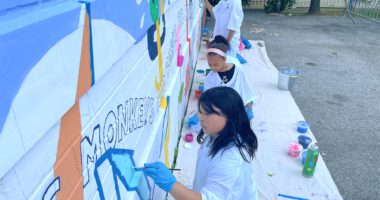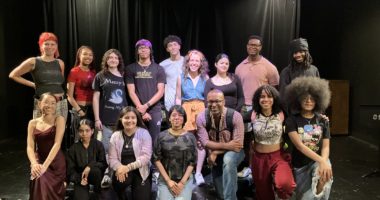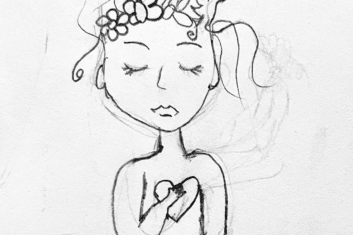I recently started the Teaching Artist Project (TAP) at Community-Word Project. In addition to immersive seminars with other adult-students, we are placed in a weekly classroom internship. I’ve been asked to intern in a first grade class at P.S. 316 in Crown Heights shadowing Teaching Artists Mary Cinadr and Shawn Ferreyra. Mary and Shawn are co-teaching and use their individual artistic disciplines of writing and visual art to collaborate in a way that best facilitates teaching their residency goal, which is to teach the students virtues and qualities for global citizenship and visual storytelling in order to explore narrative expression. Whoa! For first graders? That’s a lot! In order to do this the Teaching Artists have created smaller lessons, whereby larger elements are broken down into more digestible pieces so that the students learn incrementally and in a way that each concept builds off the next, week by week.
In the first lesson, Shawn and Mary introduced themselves to the children by stating their name and what their artistic discipline is. It was very impressive how they used this small action as a teaching moment. After Mary said, “I’m a writer”, she immediately followed it up by unpacking what that means. She asked the kids, “What do writers do?” and the children collectively worked at defining what a writer does. Shawn did the same thing when he told the kids he is a visual artist and someone who draws comics. They defined those words as a group so that everyone had a greater understanding of who the new grown-ups in the room were and what they will be sharing.
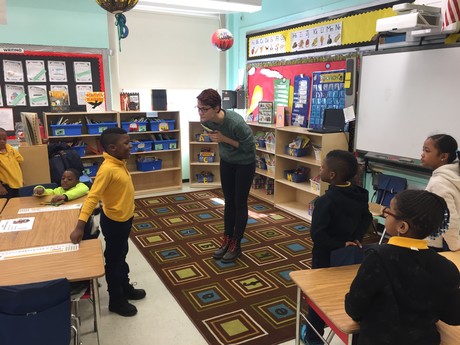
Next, the Teaching Artists activated the children’s enthusiasm for art and for learning. Shawn and Mary got the kids excited by saying that they were going to have some “serious fun” together. They looked more closely at that phrase by acknowledging that sounds weird because those are two words that don’t normally go together: Serious and Fun. They asked the first graders to embody the word “serious” and then the word “fun” and used this as a transition into discussing how to be a respectful, engaged, and active participant so that everyone can feel safe to express him or herself.


Thus far in the internship, the Teaching Artists have been focused on teaching the students qualities of character. They’ve introduced this in a few ways. On day one, Shawn asked the children to describe qualities that represent him. The kids shouted out answers like “cool, funny, smart, nice etc”, which introduced the idea that qualities create character. Then, Shawn and Mary introduced the character of a “Peaceful Warrior” and they asked what qualities a peaceful warrior has. The children said things like “loving, patient, kind, sharing, nice, forgiveness, compassionate, brave, etc.” The Teaching Artists then built off this idea that qualities create character through visual art and by using animals as an example. In the second lesson, Shawn started to draw animal characters that embodied some of these traits on a large sheet of paper. Even the process of doing this was used as a learning moment. Mary asked the children, “don’t guess what the animal is yet, but describe what shapes you see, what do you notice.” Shawn drew animals like an elephant, an owl, a squirrel, a sloth etc. Mary facilitated a discussion where they spoke about the qualities of the animal and what that might teach us about them. For example, elephants grieve when they lose someone so the elephant teaches us compassion. The sloth shows forgiveness because when it’s awakened it forgives and goes right back to sleep. They took this a step further by asking the children to explain what compassion or forgiveness means to them.


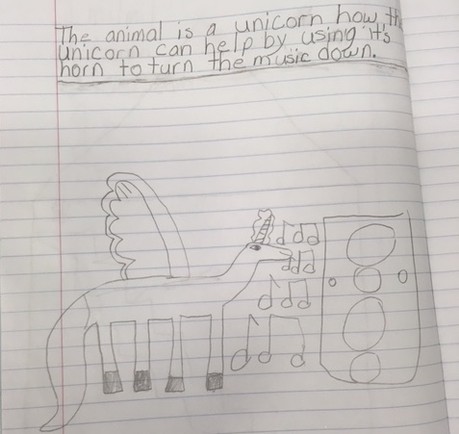

In the most recent lesson, Shawn and Mary reviewed the animals Shawn had previously drawn and their characteristics. They built upon this by saying that now they get to create their own animals. The Teaching Artists had the children brainstorm about what animals they would like to create. Mary told the first graders that they don’t have to be realistic animals – that they can look however they want them to look and act however they want the them to act – but they have to have a “secret ingredient”. The “secret ingredient” is that the animal needs to have a characteristic that will help make the community better. Before the students could start drawing (which they were all very eager to do!) they had to go back to their seat and write. This is where I was introduced more into the fold. Mary asked me to go around and see if they need help getting the ideas out or writing things down. I worked with one child who said that his animal is a pig that helps cleanup the city by eating all the garbage, a girl who said her animal was a bear who helps the cars by making them stop at the stoplight, another boy had a snake with a hundred legs who ‘helped crime by biting all the robbers’. Sometimes when kids got stumped I coaxed more ideas out of them. One child just had “Cat” written on the paper and was more excited about engaging with her classmates character creations than committing to her own. I tried to get this student to dig deeper by asking what the cat looks like, how it acts, what’s something you want to change about your community that it can help with. When this lesson was finished the children were still in the process of drawing rough sketches of their animals and discovering new qualities. I’m sure next time we will pick up from where we left off, but all the kids seem really excited about this project and are retaining the information from week to week in a way that is deepening their learning and expanding their creativity.
-Cayenne Douglass, 2017-18 TAP Trainee

